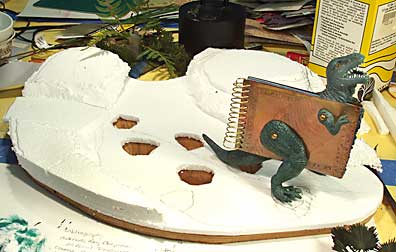I got some very dense polystyrene for modelers to block in the land areas. To get clear dinosaur footprints in the creek bed, I made them with Primo. They will be embedded in the creek bottom.

In the photo above the base is cut from a piece of plywood. I roughly cut polystyrene layers into the shapes I want. There is a small rise in the back for the palm trees. There are also holes in the bottom sheet of polystyrene so I can set the footprints in. All these parts were glued together with PVA and left to dry under books. I will put a few screws through the polystyrene and into the plywood base when it’s dry. There is some disagreement about whether or not PVA works with polystyrene, but I didn’t want to use a non-water based glue. After leaving the landscape under books for two days it feels like a very firm attachment.
There is often a point in the middle of a big project when I want to quit. I could just stick it in a cupboard and start something new and more exciting. I’m struggling with that right now. But looking at the landscape gets me excited again. Does anyone have any tips for staying engaged with your work when you're running out of steam? I hope it's not just me.


2 comments:
I know what you mean about that point in the middle of the project! The most help ever got on that problem was Ann Hechle's lecture and art at Letterforum in 1990 (I think). The subject was the first hexagram in the I Ching, having to do with creation and creative impulse. She talked about the different stages of creativity, moving through the changing lines of the hexagram. I'm probably butchering this, but they included:
1. waiting and listening to the first seeds of creative impulse;
2. first tentative steps toward making;
3. working through the difficulties that arise and getting support and input from others;
4. uncertainty, chaos, sometimes redirection (the toughest part for me);
5. everything coming together, coalescing on the page;
6. knowing when to quit, and/or knowing when to let go of it after you've finished it.
Anyway, it helps me if remember to consider that the chaos is a necessary part of the creative process.
He looks like he's walking in the snow, leaving behind big footprints all the way down to the mud. Perhaps he's heading to some Winter Olympic Extinction event!
Post a Comment